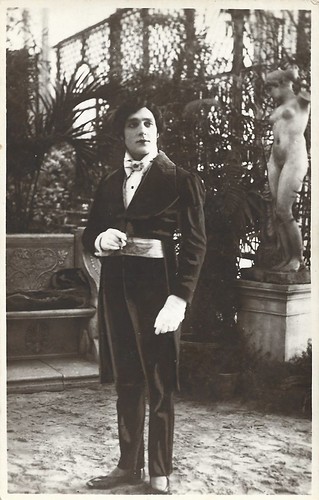
Italian postcard by Unione Cinemagrafica Italiana. Photo: Medusa Film. Carlo Gualandri as Don Giovanni Saracinesca in Saracinesca (Gaston Ravel, 1921). Caption: Don Giovanni Saracinesca.
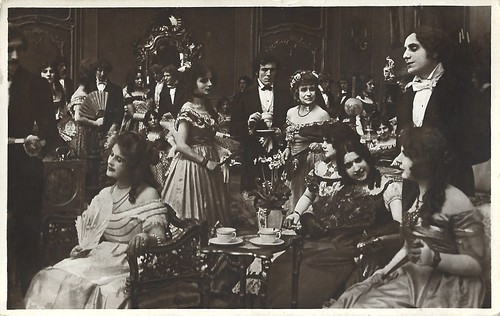
Italian postcard by Unione Cinemagrafica Italiana. Photo: Medusa Film. Carlo Gualandri as Don Giovanni Saracinesca in Saracinesca (Gaston Ravel, 1921). Caption: A reception. The man far left may be Don Giovanni Saracinesca.
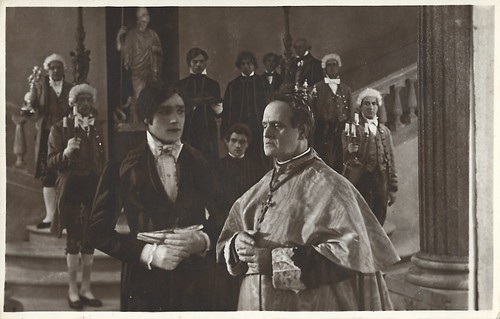
Italian postcard by Unione Cinemagrafica Italiana. Photo: Medusa Film. Carlo Gualandri as Don Giovanni Saracinesca in Saracinesca (Gaston Ravel, 1921). Caption: The day he hears that the young Prince Saracinesca wants to marry Donna Tullia Mayer, the cardinal doesn't hide his disapproval.
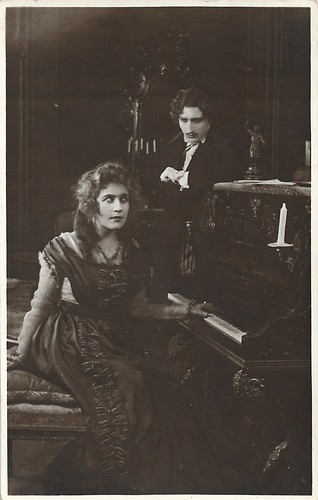
Italian postcard by Unione Cinemagrafica Italiana. Photo: Medusa Film. Alfredo Martinelli as Del Ferice and Sigrid Lind as Dona Tullia in Saracinesca (Gaston Ravel, 1921). Caption: The scheming and coquette Donna Tullia stands in a good relationship with the liberals and knows she is no party for the young Prince.

Italian postcard by Unione Cinemagrafica Italiana. Photo: Medusa Film. Carlo Gualandri as Don Giovanni Saracinesca and Elena Sangro as Corona d'Astradente in Saracinesca (Gaston Ravel, 1921). Caption: Don Giovanni Saracinesca meets Corona for the first time. (In the back, Donna Tullia and De Feriel look worried at them.)
An extremely popular novel
Little is known about Saracinesca (Gaston Ravel, 1921). It was based on an extremely popular novel (1887) by Frances Marion Crawford and is set in Rome in the 1860s, then still part of the Papal State. Ivo Blom subtracted the plot of the film from Crawford's novel as indicated on Project Gutenberg.
At a reception at the Embassy, Don Giovanni Saracinesca (Carlo Gualandri) meets Corona D'Astrardente (Elena Sangro), married to an old Duke, a dandy. Giovanni's father wants him to marry the young, rich widow Don Tullia Mayer, but he is hesitant himself, so he asks Corona for advice. Tullia is close with Ugo Del Ferice, who is close with the revolutionaries such as the painter Gouache, but mostly involved with his own interests, waving with the political tides.
Tullia tolerates him as her smooth-talking spy and lapdog. Del Ferice's only weak spot is his detestation of Saracinesca, eager to set a trap for him. At the opera, Giovanni confesses his love to Corona, while the Duke is too deaf to overhear them. At the Frangipani ball, cardinal Antonelli warns Giovanni against marriage with Tullia Mayer, because of her acquaintance with Del Ferice (an arrivé) and his liberal circle.
At the ball, Giovanni forgets his promised dance with Tullia when he talks to Corona. Terribly angered, Tullia makes a scene and leaves. Del Ferice overhears a conversation between Giovanni and Corona, in which she rejects his love. Giovanni calls him a dog. Giovanni's father helps him set up a duel with Del Ferice.
The duel is fierce, and there is also foul play by Del Ferice and his second. Both Giovanni and Del Ferice are wounded but don't die. After the ball, the Duke confesses to Corona he is ill beyond cure. Giovanni's father meets Tullia, who thinks the duel was about her, and Corona, who is offended to hear the duel was about her and is also appalled when she hears about the foul play of Del Ferice and his second, which could have caused Giovanni's death.
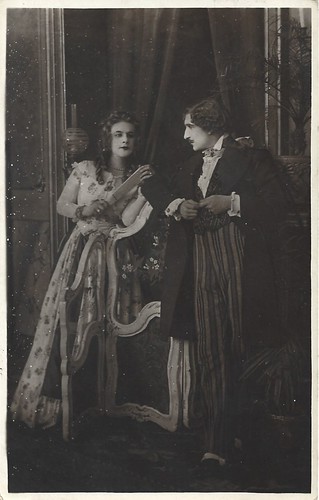
Italian postcard by Unione Cinemagrafica Italiana. Photo: Medusa Film. Alfredo Martinelli as Del Ferice in Saracinesca (Gaston Ravel, 1921). Caption: Plotting against Don Giovanni Saracinesca.

Italian postcard by Unione Cinemagrafica Italiana. Photo: Medusa Film. Alfredo Martinelli as Del Ferice in Saracinesca (Gaston Ravel, 1921). Caption: De Feriel at the opera.
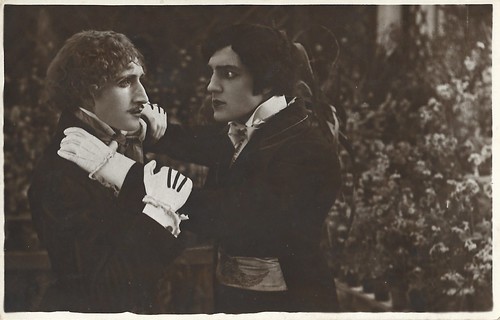
Italian postcard by Unione Cinemagrafica Italiana. Photo: Medusa Film. Carlo Gualandri as Don Giovanni Saracinesca and Alfredo Martinelli as Del Ferice in Saracinesca (Gaston Ravel, 1921). Caption: Don Giovanni Saracinesca threatens Del Ferice (named on the card: De Feriel).
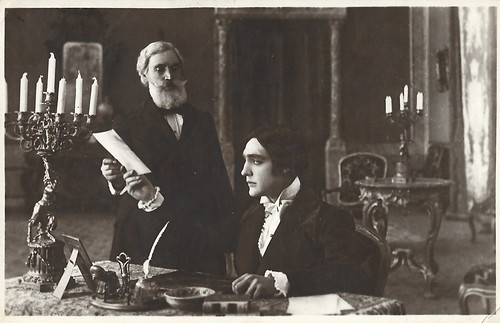
Italian postcard by Unione Cinemagrafica Italiana. Photo: Medusa Film. Carlo Gualandri as Don Giovanni Saracinesca in Saracinesca (Gaston Ravel, 1921). Caption: Before the duel, Saracinesca gives his last will to his notary.
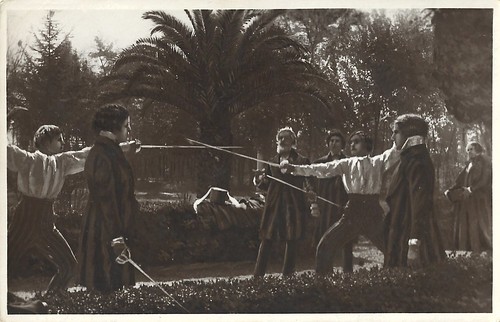
Italian postcard by Unione Cinemagrafica Italiana. Photo: Medusa Film. Carlo Gualandri as Don Giovanni Saracinesca, at left, in Saracinesca (Gaston Ravel, 1921). Caption: The duel.
Giovanni and Corona marry at last
Afterwards, the Duke hears that Giovanni's second killed Del Ferice's second over foul play, but he is also told the first duel was over his wife, and he explodes. He confronts his wife, she rebukes the affair, he forgives her, falls on his knees... and dies. Giovanni's father then doesn't oppose any marriage, as Corona is a rich widow now. Cardinal Antonelli visits her and convinces her to create a salon for the papal party. Corona intends to leave for the countryside, in vain Giovanni tries to prevent this.
Meanwhile, Del Ferice is cured and plots with Tullia to kill Corona and humiliate Giovanni by preventing their marriage. In exchange for not telling a secret, Tullia promises to marry Del Ferice. Del Ferice, namely, has found out Giovanni is already married. Corona has retreated to the Astradente residence in the countryside. Not far from there is also the Saracinesca estate. Giovanni's father visits the Duchess, sets up a meeting, and proposes Corona marry Giovanni, as they would be a perfect match, socially and materially. A reconciliation between the young couple happens and they declare each other their love. Yet, shortly before they marry, Tullia visits Corona and tells her about Giovanni's earlier marriage to a peasant woman called Felice Baldi. Yet, Corona calls Giovanni and his father, who press Tullia to show proof within 24 hours.
Tullia runs to Del Ferice, who immediately understands what she has done: tell what was secret. He gives her copies of the marriage certificate, knowing she will marry him now. Giovanni suspects De Ferice is behind Tullia's scheme. When Tullia presents the papers, Giovanni's unmasking of a (possible) fraud makes her doubt De Ferice's intentions and she storms out again. Giovanni's father goes to Aquila and finds out there was a namesake and even a distant relative also called Giovanni Saracinesca. Giovanni and Corona marry at last. Giovanni's father urges the Cardinal to arrest Del Ferice as a spy. They send the police after Del Ferice and his servant, but Del Ferice flees dressed as a beggar friar. On the road, Giovanni and Corona meet him, but on Corona's request his life is spared and Giovanni lets him go.
According to Wikipedia, "Crawford, though an American by parentage and citizenship, was born in the Italian resort of Bagni de Lucca, spent most of his life abroad, and wrote 'Saracinesca' while living in Sant' Agnello di Sorrento, Italy." After the success of his book, Crawford continued with several sequels: "She followed it with two brilliant sequels, 'Sant'Ilario' and 'Don Orsino', the three of which are usually considered a trilogy. Subsequent sequels, such as 'Corleone', continue the saga of the Saracinesca family, but with a diversion from the previous focus on the drama and status of family members into heavily plotted, incident-heavy melodrama. Characters from Saracinesca and its sequels also appear in 'A Lady of Rome' (1906) and 'The White Sister' (1909).
The film version, Saracinesca (Gaston Ravel, 1921), unfortunately, was less successful with Italian critics, according to two reviews in Vittorio Martinelli's reference work 'Il cinema muto italiano, Vol. 1921-22'. The film premiered in Rome on 31 January 1923. Next to Gaston Ravel, IMDb and Wikipedia mention a second director of the film. It's Augusto Camerini, the brother of the more famous director Mario Camerini and the cousin of another famous director, Augusto Genina. Augusto Camerini was a well-known painter, illustrator and cartoonist and also worked as a writer and assistant film director. In the years 1920-1921, he directed six films. Later he directed three more films.
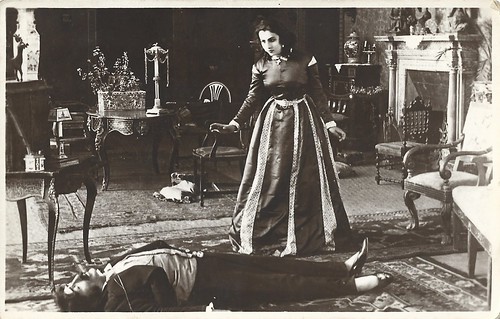
Italian postcard by Unione Cinemagrafica Italiana. Photo: Medusa Film. Elena Sangro as Corona d'Astradente in Saracinesca (Gaston Ravel, 1921). Caption: After the killing of her husband, Corona d'Astradente has become a rich heiress.
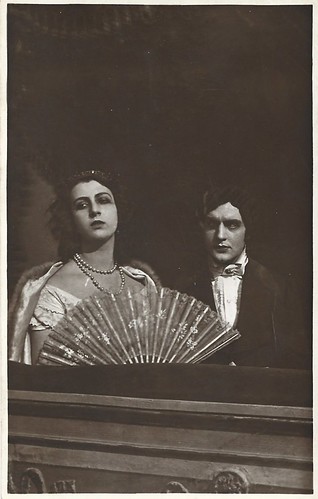
Italian postcard by Unione Cinemagrafica Italiana. Photo: Medusa Film. Elena Sangro as Corona d'Astradente and Carlo Gualandri as Don Giovanni Saracinesca in Saracinesca (Gaston Ravel, 1921). Caption: [At the opera] Corona and Giovanni are now husband and wife.

Italian postcard by Unione Cinemagrafica Italiana. Photo: Medusa Film. Elena Sangro as Corona d'Astradente and Carlo Gualandri as Don Giovanni Saracinesca in Saracinesca (Gaston Ravel, 1921). Caption: Don Giovanni Saracinesca holds his new wife Corona tight, whispering: You are the best among the women - and the most beloved!
Sources: Guttenberg, Vittorio Martinelli (La carrière italienne de Gaston Ravel (1919-1922) - French), Wikipedia (Italian) and IMDb.
No comments:
Post a Comment